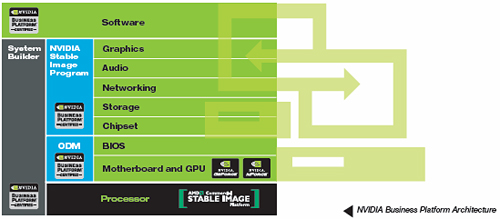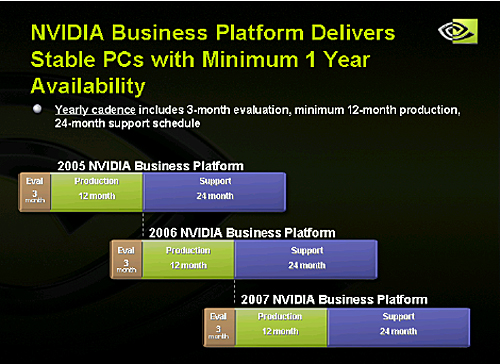NVIDIA Business Platform: A competitive desktop alternative to Intel?
by Gary Key on March 30, 2006 12:15 AM EST- Posted in
- IT Computing
NVIDIA Business Platform Features
HP, Dell, Gateway, and the majority of tier-one OEMs have been offering various forms of stable image platforms through their business, education, or government solutions groups in recent years. As the complexity and size of enterprise level networks grew, along with the proliferation of networks in other sectors, it became apparent that a different level of integration between hardware and software was required. So, in mid-2003, Intel formally stepped into this market segment with their Stable Image Platform Program (SIPP), and following Intel's tremendous success, AMD introduced their Commercial Stable Image Platform (CSIP) in September of 2005.
Highlights of the program include the NVIDIA Stable Image Platform design that defines the software foundation of the NVIDIA Business Platform. It combines drivers for graphics, audio, networking, storage, and other media & communication processor functionality into a single binary image. NSIP guarantees a single binary image deployment across all platforms, regardless of integrated or discrete graphic configurations. This differs from Intel's image certification which is for integrated graphics only at this time.
Also, NVIDIA offers the only hardware-based firewall solution for a stable image platform, with NVIDIA stating their unique anti-hacking technology will secure each PC from network intrusion. We have not tested this claim and are awaiting a test system to verfiy this feature. Hardware-based firewall technology protects PCs at the network layer from most virus, worm, and spyware attacks. Unlike software-based firewall solutions, ActiveArmor cannot be disabled by malicious code according to NVIDIA. NVIDIA worked closely with Microsoft and Altiris to ensure their new ActiveArmor Firewall allows remote management traffic while still protecting against malware. Wake-on-LAN, PXE, and Firewall filtering is built into the network interface hardware to enable full remote management of the PC provided a network connection and power source is available.
HP, Dell, Gateway, and the majority of tier-one OEMs have been offering various forms of stable image platforms through their business, education, or government solutions groups in recent years. As the complexity and size of enterprise level networks grew, along with the proliferation of networks in other sectors, it became apparent that a different level of integration between hardware and software was required. So, in mid-2003, Intel formally stepped into this market segment with their Stable Image Platform Program (SIPP), and following Intel's tremendous success, AMD introduced their Commercial Stable Image Platform (CSIP) in September of 2005.

Highlights of the program include the NVIDIA Stable Image Platform design that defines the software foundation of the NVIDIA Business Platform. It combines drivers for graphics, audio, networking, storage, and other media & communication processor functionality into a single binary image. NSIP guarantees a single binary image deployment across all platforms, regardless of integrated or discrete graphic configurations. This differs from Intel's image certification which is for integrated graphics only at this time.
Also, NVIDIA offers the only hardware-based firewall solution for a stable image platform, with NVIDIA stating their unique anti-hacking technology will secure each PC from network intrusion. We have not tested this claim and are awaiting a test system to verfiy this feature. Hardware-based firewall technology protects PCs at the network layer from most virus, worm, and spyware attacks. Unlike software-based firewall solutions, ActiveArmor cannot be disabled by malicious code according to NVIDIA. NVIDIA worked closely with Microsoft and Altiris to ensure their new ActiveArmor Firewall allows remote management traffic while still protecting against malware. Wake-on-LAN, PXE, and Firewall filtering is built into the network interface hardware to enable full remote management of the PC provided a network connection and power source is available.











14 Comments
View All Comments
Schadenfroh - Thursday, March 30, 2006 - link
I have been using my nvidia firewall for over a year without any problems.FinFET - Thursday, March 30, 2006 - link
From what I read "AMT enables IT staff to diagnose, repair, and manage remote PCs regardless of OS or system state."So is this basically like ILO (Integrated Lights Out) where I can have BIOS Level access to the machine, essentially IP-KVM?
If so does the current iteration of boards with NVIDIA ActiveArmor support this type of feature?
Gary Key - Thursday, March 30, 2006 - link
The NVIDIA nForce boards and software being designed for this stable image platform fully support WOL/PXE. This offering is basically an updated version of the WOL/PXE capabilities provided on the nForce Professional 2050/2200 boards with specialized driver and software support.
tokath - Thursday, March 30, 2006 - link
They don't support anything close to the level AMT but there is likely an option that will allow ASF to be enabled if the vendor wants it.AMT is not essentially an IP-KVM because you do not have direct access to the system, keyboard, mouse, video. Rather AMT requires a separate application such as LANDesk to allow you to control the more advanced aspects, when you access the system remotely without any extra software you can do simple things like turn the system on/off, reboot, view temps and check the OS state. Because the Intel LOM (PRO/1000 PM) that has AMT also supports IDE-R and SOL you can do some very useful things like boot from a remote CD to restore the system. Theoretically vendors can create custom software to do a lot more through AMT.
That said I sure hope NVIDIA LOMs will support ASF (preferably 2.0), there are alot of business that use ASF.